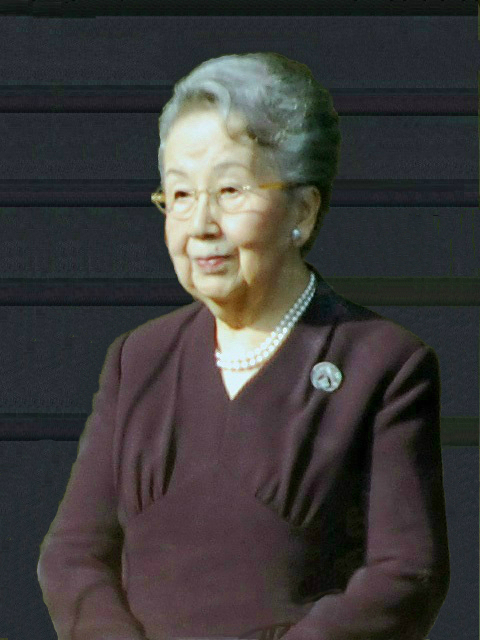by Susan Flantzer © Unofficial Royalty 2016

Prince Mikasa of Japan; Credit – Wikipedia
Prince Mikasa of Japan, the youngest of the four sons of Emperor Taishō and Empress Teimei, was born on December 2, 1915, at the Tokyo Imperial Palace in Tokyo, Japan. His childhood appellation was Sumi-no-miya and he was also known by his personal name Prince Takahito.
He had three older brothers:
- Emperor Hirohito (Shōwa) (1901 – 1989), married Princess Nagako of Kuni, had issue including Emperor Akihito
- Prince Chichibu (1902 – 1953), married Setsuko Matsudaira, no issue
- Prince Takamatsu (1905 – 1987), married Kikuko Tokugawa, no issue

Emperor Taishō’s four sons in 1921: Hirohito, Mikasa, Takamatsu, and Chichibu; Credit – Wikipedia
Prince Mikasa was educated at the Gakushūin (Peers’ School), established in 1847 to educate the children of Japanese nobility. After graduating in 1932, Mikasa began a military career. He entered the Imperial Japanese Army Academy and upon graduation was commissioned a sub-lieutenant. Mikasa furthered his military education by attending the Army War College. In December 1935, Emperor Hirohito (Shōwa) granted him the title Mikasa-no-miya (Prince Mikasa) and the authorization to form a new branch of the Imperial Family.

Prince Mikasa in 1936; Credit – Wikipedia
During World War II, Prince Mikasa, having attained the rank of major, served as a staff officer at the headquarters of the China Expeditionary Army in Nanjing, China. His goal was to strengthen the legitimacy of the nationalist government in Nanking and to coordinate a peace initiative, but his efforts were unsuccessful due to Operation Ichi-Go launched by the Imperial General Headquarters.
During his time in China, Prince Mikasa became aware of plans for a Japanese bombing of Chinese cities with bubonic plague bombs. Upon his return to Japan, Mikasa wrote a report about the bubonic plague bombs and other war atrocities he had witnessed, but the report was suppressed until 1994. In 1946, Prince Mikasa spoke to the Privy Council of Japan insisting that his brother Emperor Hirohito needed to abdicate and take responsibility for the war. However, General Douglas MacArthur, who was responsible for the Allied Occupation of Japan, protected Emperor Hirohito and insisted that he should stay in power.
On October 22, 1941, Prince Mikasa married Yuriko Takagi, daughter of Japanese noble Viscount Masanari, who was known as Princess Mikasa after her marriage. The couple had three sons and two daughters. Prince Mikasa and his family lived on the grounds of the Akasaka Palace in Tokyo. All three sons predeceased their parents.
- Yasuko Konoe, formerly Princess Yasuko (born 1944), married Tadateru Konoe, had one daughter; upon her marriage, Princess Yasuko had to relinquish her title from birth and her official membership in the Imperial Family
- Prince Tomohito (1946 – 2012), married Nobuko Asō, had two daughters
- Prince Katsura (1948 – 2014), unmarried
- Masako Sen, formerly Princess Masako (born 1951), married Sōshitsu Sen, had two sons and one daughter; upon her marriage, Princess Masako had to relinquish her title from birth and her official membership in the Imperial Family
- Prince Takamado (1954 – 2002), married Hisako Tottori, had three daughters

Princess Mikasa and her three elder children, circa 1950; Credit – Wikipedia

Princess Mikasa in 2012; Photo Credit – Wikipedia
After World War II, Prince Mikasa studied archaeology, Middle Eastern studies, and Semitic languages at the University of Tokyo. From 1954 until he died in 2016, he directed the Japanese Society for Middle East Studies. He also held visiting and guest faculty appointments in Middle Eastern studies and archaeology at universities in Japan and abroad.
Embed from Getty Images
Prince Mikasa and Princess Mikasa wave to well-wishers gathered for the annual New Year’s greetings at the Imperial Palace in Tokyo on January 2, 2016
Prince Mikasa died of heart failure on October 27, 2016, at the age of 100, a little more than a month before his 101st birthday. At the time of his death, he was the world’s oldest royal, the longest-lived member of the Japanese Imperial Family, and the last of the five Japanese princes in the line of succession. Prince Mikasa lived during the reigns of three emperors: his father Emperor Taishō, his brother Emperor Hirohito, and his nephew Emperor Akihito.
Prince Mikasa’s funeral, called the Renso-no-Gi (Ceremony of the Funeral and Entombment), was held on November 4, 2016, at the Toshimagaoka Imperial Cemetery in Tokyo. The host of the funeral was the prince’s 93-year-old widow Princess Mikasa. Due to Princess Mikasa’s advanced age, Princess Akiko, the eldest daughter of the late Prince Tomohito, the eldest son of Prince Mikasa, stood in for her. Other members of the Imperial Family, other relatives, Prime Minister Shinzo Abe, parliamentary leaders, and foreign ambassadors to Japan attended the funeral. As is the custom, Emperor Akihito and Empress Michiko did not attend the funeral.
Prince Mikasa’s wife Yuriko, Princess Mikasa survived her husband by eight years, dying of old age, on November 15, 2024, at St. Luke’s International Hospital in Tokyo, Japan aged 101.
This article is the intellectual property of Unofficial Royalty and is NOT TO BE COPIED, EDITED, OR POSTED IN ANY FORM ON ANOTHER WEBSITE under any circumstances. It is permissible to use a link that directs to Unofficial Royalty.
